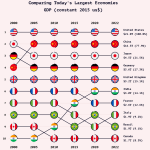Within the final part, I defined two search algorithms that work on inverted index. These algorithms are precise, that means that the okay greatest candidates they return are the true okay greatest candidates. Sounds trite? Effectively, it is a query we should always ask ourselves each time we design search algorithms on large-scale information, as a result of in lots of situations it isn’t essential to get the true okay greatest candidates.
Take into consideration the Spotify instance once more: do you actually care if the results of a search might miss a couple of folks with comparable style as yours? Most individuals perceive that in on a regular basis functions (Google, Spotify, Twitter, and many others.), the search isn’t exhaustive or precise. These functions will not be mission important sufficient to justify precise search. Because of this probably the most extensively used search algorithms are all approximate.
There are primarily two advantages of utilizing approximate search algorithms:
- Sooner. You may minimize many corners should you now not want precise outcomes.
- Predicable useful resource consumption. This one is much less apparent, however for a number of approximate algorithms, their useful resource utilization (e.g., reminiscence) may be configured a priori unbiased of knowledge distribution.
On this publish, I write about probably the most extensively used approximate index for Jaccard: Minwise Locality Delicate Hashing (MinHash LSH).
What’s LSH?
Locality Delicate Hashing indexes are true wonders in laptop science. They’re algorithmic magic powered by quantity idea. In machine studying literature, they’re k-NN fashions, however not like typical machine studying fashions, LSH indexes are data-agnostic so their accuracy conditioned on similarity may be decided a priori earlier than ingesting new information factors or altering information distribution. So, they’re extra just like inverted indexes than a mannequin.
An LSH index is actually a set of hash tables every with a distinct hash operate. Similar to a typical hash desk, an LSH index’s hash operate takes a knowledge level (e.g., a set, a characteristic vector, or an embedding vector) as enter, and outputs a binary hash key. Apart from this, they can’t be extra totally different.
A typical hash operate outputs keys which might be pseudo-randomly and uniformly distributed over the whole key area for any enter information. For instance, MurmurHash is a well known hash operate that outputs near-uniformly and randomly over a 32-bit key area. Which means that for any two inputs, corresponding to abcdefg and abcefg, so long as they’re totally different, their MurmurHash keys shouldn’t be correlated and will have the identical chance to be any one of many keys in the whole 32-bit key area. This can be a desired property of a hash operate, since you need even distribution of keys over hash buckets to keep away from chaining or continually resizing your hash desk.
An LSH’s hash operate does one thing reverse: for a pair of comparable inputs, with similarity outlined by way of some metric area measure, their hash keys must be extra more likely to be equal, than one other pair of hash keys of dis-similar inputs.
What does this imply? It signifies that an LSH hash operate has greater chance of hash key collision for information factors which might be extra comparable. Successfully, we’re using this greater collision chance for similarity-based retrieval.
MinHash LSH
For each similarity/distance metric, there’s an LSH hash operate. For Jaccard, the operate known as Minwise Hash Perform, or MinHash operate. Given an enter set, a MinHash operate consumes all parts with a random hash operate and retains observe of the minimal hash worth noticed. You may construct an LSH index utilizing a single MinHash operate. See the diagram under.
The mathematical idea behind MinHash operate states that the chance of two units having the identical minimal hash worth (i.e., hash key collision) is similar as their Jaccard.
min(h(A)) is the minimal hash worth of all parts in A.
It’s a magical consequence, however the proof is kind of easy.
A MinHash LSH index with a single MinHash operate doesn’t provide you with passable accuracy as a result of the collision chance is linearly proportional to the Jaccard. See the next plot to know why.
Think about we draw a threshold at Jaccard = 0.9: outcomes with greater Jaccard than 0.9 with the question set is related, wheres outcomes with decrease than 0.9 Jaccard are irrelevant. Within the context of search, the notion of “false constructive” signifies that irrelevant outcomes are returned, wheres the notion of “false destructive” signifies that related outcomes will not be returned. Based mostly on the plot above and searching on the space akin to false constructive: if the index solely makes use of a single MinHash operate, it will produce false positives at a really excessive chance.
Boosting the Accuracy of MinHash LSH
This why we’d like one other LSH magic: a course of referred to as boosting. We are able to enhance the index to be rather more attuned to the relevancy threshold specified.
As an alternative of just one, we use m MinHash capabilities generated by way of a course of referred to as Universal Hashing — principally m random permutations of the identical hash operate of 32-bit or 64-bit integer. For each listed set, we generate m minimal hash values utilizing common hashing.
Think about you checklist the m minimal hash values for an listed set. We group each r variety of hash values right into a band of hash values, and we make b such bands. This requires m = b * r.
The chance that two units having “band collision” — all of the hash values in a band collide between two units, or r contiguous hash collisions, is Jaccard(A, B)^r. That’s loads smaller than a single hash worth. Nonetheless, the chance of getting at the least one “band collision” between two units is 1 — (1-Jaccard(A, B)^r)^b.
Why will we care about 1 — (1-Jaccard(A, B)^r)^b? As a result of this operate has a particular form:
Within the plot above, you’ll be able to see by utilizing m MinHash capabilities, the “at-least-one band collision” chance is an S-curve operate with a steep rise round Jaccard = 0.9. Assuming the relevancy threshold is 0.9, the false constructive chance of this index is far smaller than the index that makes use of just one random hash operate.
Due to this, an LSH index at all times makes use of b bands of r MinHash capabilities to spice up accuracy. Every band is a hash desk storing tips to listed units. Throughout search, any listed set collides with the question set on any band is returned.
To construct an MinHash LSH index, we will specify a previous a relevancy threshold and acceptable false constructive and destructive possibilities conditioned on Jaccard similarity, and calculate the optimum m, b and r, earlier than indexing any information factors. This can be a nice benefit of utilizing LSH over different approximate indexes.
You could find my implementation of MinHash LSH within the Python package deal datasketch. It additionally has different MinHash-related algorithms like LSH Forest and Weighted MinHash.
I’ve lined a variety of subjects on this publish, however I barely scratched the floor of search indexes for Jaccard similarity. In case you are excited about studying extra about these subjects, I’ve a listing of additional readings for you:
- Mining of Massive Datasets by Jure Leskovec, Anand Rajaraman and Jeff Ullman. The third chapter goes into element about MinHash and LSH. I feel it’s a nice chapter for gaining the instinct of MinHash. Bear in mind the applying described within the chapter is targeted on n-gram primarily based textual content matching.
- JOSIE: Overlap Set Similarity Search for Finding Joinable Tables in Data Lakes. The preliminary part of this paper explains the intuitation behind the
search_top_k_merge_listandsearch_top_k_probe_setalgorithms. The primary part explains how you can take price into consideration when enter units are giant, corresponding to a desk column. - Datasketch and SetSimilaritySearch libraries respectively implement the state-of-the-art approximate and precise Jaccard similarity search indexes. The issues list of the datasketch project is a treasure trove of software situations and sensible concerns when making use of MinHash LSH.
What about Embeddings?
In recent times, resulting from breakthroughs in illustration studying utilizing deep neural networks like Transformers, similarity between realized embedding vectors is significant when the enter information is a part of the identical area that the embedding mannequin skilled on. The primary variations between that situation and the search situation described on this publish are:
- Embedding vectors are dense vectors with usually 60 to 700 dimensions. Each dimension is non-zero. In distinction, units, when represented as one-hot vectors are sparse: 10k to tens of millions of dimensions, however most dimensions are zeros.
- Cosine similarity (or dot-product on normalized vectors) is usually used for embedding vectors. For units we use Jaccard similarity.
- It’s laborious to specify a relevancy threshold on similarity between embedding vectors, as a result of the vectors are realized black-box representations of the unique information corresponding to picture or textual content. However, Jaccard similarity threshold for units is far simpler to specify as a result of units are the unique information.
Because of the above variations, it isn’t easy to check embeddings and units as a result of they’re distinctively totally different information sorts, despite the fact that you would classify each of them as high-dimensional. They’re appropriate for various software situations.


